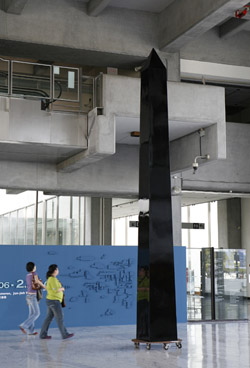

 Damien Oretga’s approach to sculpture typically consists of an elaborate form of problem-solving, based on the artist’s desire to determine what is actually possible to create, and what can only exist in concept form. One example is his 2004 wooden sculpture, Continuous/Discontinuous, which functions much like a three-dimensional diagram of an ordinary kitchen chair that has suddenly propelled itself into a 90-degree change of position, with the seats, backs and legs of what began as four separate chairs all fused together in a cartoonish blur of solid form.
Damien Oretga’s approach to sculpture typically consists of an elaborate form of problem-solving, based on the artist’s desire to determine what is actually possible to create, and what can only exist in concept form. One example is his 2004 wooden sculpture, Continuous/Discontinuous, which functions much like a three-dimensional diagram of an ordinary kitchen chair that has suddenly propelled itself into a 90-degree change of position, with the seats, backs and legs of what began as four separate chairs all fused together in a cartoonish blur of solid form.
Ortega’s larger works are capable of reconfiguring entire cars as a deconstructed mini-galaxy of discrete parts floating in space, or having an atual pair of oil barrels gyrate wildly, one precariously balanced on the edge of the other. As models of perceived reality, Ortega’s sculptures explore certain of the more perplexing boundaries between what we know to be true, and what our senses report to us. Taking things apart and putting them back together becomes code for a way of perceiving the world, in which the limits of our percepton expand to include the hidden as well as the visible.
Portable Obelisk, Ortega’s project for Taipei, is based on a prototype concept that has existed in his work for some time: the monument which can be moved about from one place to another. Although Ortega has not specifically appropriated the Washington monument in the U.S. capital, he has duplicated the scale and phallic exaggeration of the original closely enough that only a determined pre-Feudian would have any difficulty recognizing it. Ortega’s most recent innovation is to attach a rope to the base on which his monument is balanced, so that it really can be adjusted or moved by anyone who wants to.
There is also, of course, a political reading to many of Ortega’s most compelling works, although this approach does not seem ideologically grounded so much as concerned with broader questions of how we perceive history and our role in it. The image of a world teetering on the edge of an oil barrel, or a monument that symbolizes so little of substance it can be moved from one site to another as its fortunes dictate – these are like visual riddles pointed at the enigmas of history as opposed to a form of polemics in favor of one position or another. For all of Ortega’s down-to-earth pragmatics, there is always an idealist aspect to his art, one that seeks to wants to re-stage the world in the form of our most pressing questions about it.